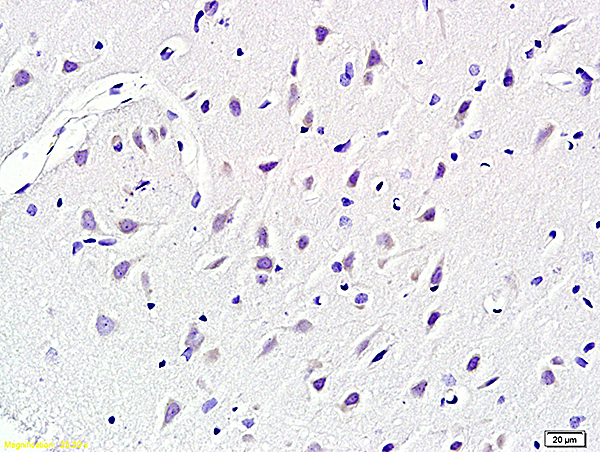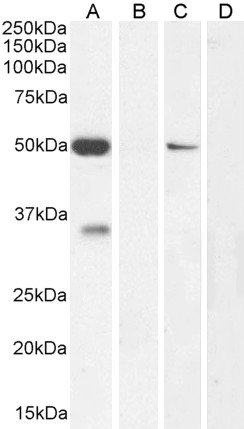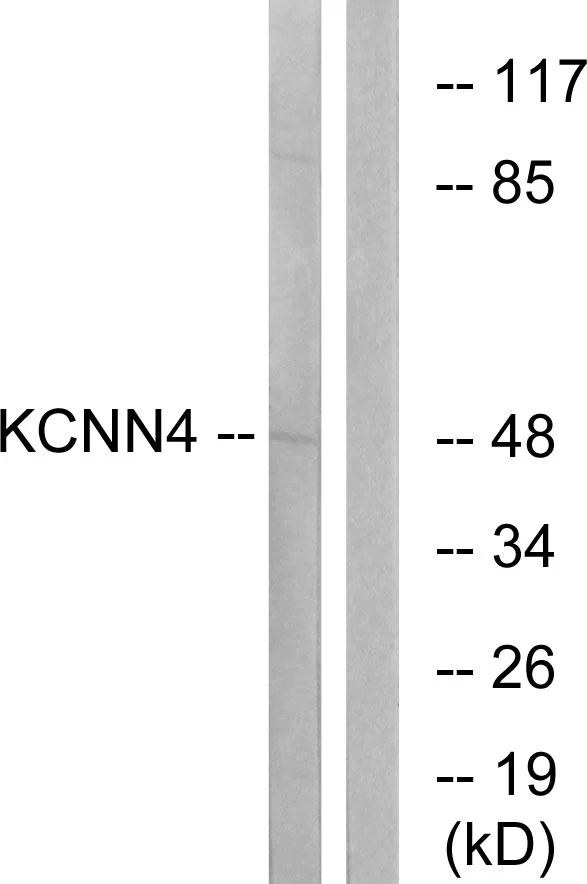![FACS analysis of Raji cells using GTX00627 KCNN4 antibody [6C1]. Black : Negative control Gray : Isotype control Green : Primary antibody Dilution : 1:20 FACS analysis of Raji cells using GTX00627 KCNN4 antibody [6C1]. Black : Negative control Gray : Isotype control Green : Primary antibody Dilution : 1:20](https://www.genetex.com/upload/website/prouct_img/normal/GTX00627/GTX00627_20190906_FACS_1_w_23053121_319.webp)
FACS analysis of Raji cells using GTX00627 KCNN4 antibody [6C1]. Black : Negative control Gray : Isotype control Green : Primary antibody Dilution : 1:20
KCNN4 antibody [6C1]
GTX00627
ApplicationsFlow Cytometry, ImmunoFluorescence, ImmunoPrecipitation, Western Blot, ImmunoCytoChemistry, ImmunoHistoChemistry, Other Application
Product group Antibodies
ReactivityHuman, Mouse, Rat
TargetKCNN4
Overview
- SupplierGeneTex
- Product NameKCNN4 antibody [6C1]
- Delivery Days Customer9
- ApplicationsFlow Cytometry, ImmunoFluorescence, ImmunoPrecipitation, Western Blot, ImmunoCytoChemistry, ImmunoHistoChemistry, Other Application
- CertificationResearch Use Only
- ClonalityMonoclonal
- Clone ID6C1
- Concentration1 mg/ml
- ConjugateUnconjugated
- Gene ID3783
- Target nameKCNN4
- Target descriptionpotassium calcium-activated channel subfamily N member 4
- Target synonymsDHS2, IK, IK1, IKCA1, KCA4, KCa3.1, SK4, SKCa4, hIK1, hIKCa1, hKCa4, hSK4, intermediate conductance calcium-activated potassium channel protein 4, gardos channel, intermediate-conductance Ca2+-activated K+ channel, KCa3.1, potassium channel, calcium activated intermediate/small conductance subfamily N alpha, member 4, potassium intermediate/small conductance calcium-activated channel, subfamily N, member 4, putative Gardos channel, putative erythrocyte intermediate conductance calcium-activated potassium Gardos channel, small conductance calcium-activated potassium channel 4
- HostMouse
- IsotypeIgM
- Protein IDO15554
- Protein NameIntermediate conductance calcium-activated potassium channel protein 4
- Scientific DescriptionThe protein encoded by this gene is part of a potentially heterotetrameric voltage-independent potassium channel that is activated by intracellular calcium. Activation is followed by membrane hyperpolarization, which promotes calcium influx. The encoded protein may be part of the predominant calcium-activated potassium channel in T-lymphocytes. This gene is similar to other KCNN family potassium channel genes, but it differs enough to possibly be considered as part of a new subfamily. [provided by RefSeq, Jul 2008]
- ReactivityHuman, Mouse, Rat
- Storage Instruction-20°C or -80°C,2°C to 8°C
- UNSPSC12352203

![FACS analysis of THP-1 cells using GTX00627 KCNN4 antibody [6C1]. Black : Negative control Gray : Isotype control Green : Primary antibody Dilution : 1:20 FACS analysis of THP-1 cells using GTX00627 KCNN4 antibody [6C1]. Black : Negative control Gray : Isotype control Green : Primary antibody Dilution : 1:20](https://www.genetex.com/upload/website/prouct_img/normal/GTX00627/GTX00627_20190906_FACS_2_w_23053121_558.webp)
![Live cell imaging analysis of LN-CaP cells using GTX00627 KCNN4 antibody [6C1]. Panel A : Primary antibody Panel B : Live view of the cells Panel C : Merged of panel A and B Dilution : 1:20 Live cell imaging analysis of LN-CaP cells using GTX00627 KCNN4 antibody [6C1]. Panel A : Primary antibody Panel B : Live view of the cells Panel C : Merged of panel A and B Dilution : 1:20](https://www.genetex.com/upload/website/prouct_img/normal/GTX00627/GTX00627_20190906_LCI_1_w_23053121_102.webp)
![WB analysis of HEK cells transfected with human KCNN4 using GTX00627 KCNN4 antibody [6C1]. Lane 1 : HEK cells transfected with control vector Lane 2 : HEK cells transfected with human KCa3.1 Dilution : 1:250 WB analysis of HEK cells transfected with human KCNN4 using GTX00627 KCNN4 antibody [6C1]. Lane 1 : HEK cells transfected with control vector Lane 2 : HEK cells transfected with human KCa3.1 Dilution : 1:250](https://www.genetex.com/upload/website/prouct_img/normal/GTX00627/GTX00627_20190906_WB_1_w_23053121_475.webp)
![WB analysis of various samples using GTX00627 KCNN4 antibody [6C1]. Lane 1 : MS1 cell lysate Lane 2 : IEC-6 cell lysate Lane 3 : LN-CaP cell lysate Lane 4 : THP-1 cell lysate Dilution : 1:250 WB analysis of various samples using GTX00627 KCNN4 antibody [6C1]. Lane 1 : MS1 cell lysate Lane 2 : IEC-6 cell lysate Lane 3 : LN-CaP cell lysate Lane 4 : THP-1 cell lysate Dilution : 1:250](https://www.genetex.com/upload/website/prouct_img/normal/GTX00627/GTX00627_20190906_WB_2_w_23053121_583.webp)





